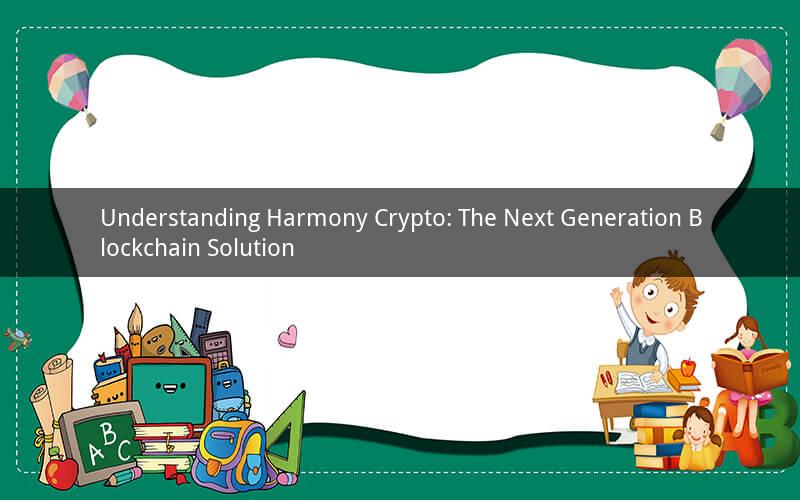
Harmony crypto has emerged as a significant player in the blockchain industry, promising a more efficient and scalable platform for decentralized applications. This article delves into what harmony crypto is, its unique features, and its potential impact on the future of digital currencies.
1. What is Harmony crypto?
Harmony crypto, also known as Harmony (ONE), is a decentralized blockchain platform designed to provide a scalable and efficient solution for developing decentralized applications (dApps). Launched in 2018, the project aims to solve the limitations of traditional blockchains, such as Ethereum, by improving throughput, reducing transaction costs, and enhancing overall network performance.
Harmony's architecture is based on a unique sharding mechanism that allows the network to process transactions simultaneously on multiple shards, leading to increased scalability and reduced latency. This makes Harmony an attractive option for developers looking to build high-performance dApps that can handle large user bases.
2. Key features of Harmony crypto
a. Sharding: As mentioned earlier, Harmony's sharding mechanism is its core feature. By dividing the network into multiple smaller, independent shards, the platform can achieve higher throughput and lower latency. Each shard operates independently, enabling parallel processing of transactions and reducing the time required for confirmation.
b. Cross-shard communication: Despite operating independently, the shards in the Harmony network can communicate with each other, enabling seamless interaction between different dApps and users. This cross-shard communication ensures that the entire network remains interconnected and functional.
c. Delegated Proof of Stake (DPoS): Harmony uses a DPoS consensus mechanism, which is more energy-efficient and faster than traditional Proof of Work (PoW) algorithms. In DPoS, token holders can vote for validators who are responsible for securing the network and validating transactions. This ensures that the network remains secure while minimizing energy consumption.
d. EVM compatibility: Harmony is fully compatible with the Ethereum Virtual Machine (EVM), allowing developers to deploy their smart contracts and dApps on the platform with ease. This interoperability makes it easier for Ethereum developers to migrate their projects to Harmony without significant modifications.
3. Benefits of using Harmony crypto
a. Scalability: One of the main advantages of Harmony is its ability to handle high transaction volumes. By utilizing sharding, Harmony can scale horizontally, allowing it to accommodate more users and dApps without compromising on performance.
b. Low transaction fees: Due to its efficient architecture and DPoS consensus mechanism, Harmony offers significantly lower transaction fees compared to other blockchains. This makes the platform more accessible to developers and users alike.
c. Energy efficiency: Harmony's DPoS consensus mechanism consumes less energy than PoW algorithms, making it a more sustainable option for the environment.
d. EVM compatibility: Harmony's compatibility with the EVM allows developers to leverage their existing Ethereum-based skills and expertise to build on the platform.
4. Potential impact on the future of digital currencies
Harmony crypto has the potential to revolutionize the blockchain industry by addressing the scalability and efficiency challenges that have plagued traditional blockchains. With its unique sharding mechanism, energy-efficient DPoS consensus, and EVM compatibility, Harmony could become a preferred platform for developing next-generation dApps and cryptocurrencies.
a. Increased adoption of dApps: As more developers adopt Harmony, the number of high-performance dApps on the platform will increase, leading to higher user engagement and a broader ecosystem.
b. Enhanced interoperability: Harmony's cross-shard communication capabilities will facilitate greater interoperability between different blockchains, allowing for seamless integration of services and applications.
c. Competition for Ethereum: With its EVM compatibility and competitive features, Harmony poses a significant threat to Ethereum's dominance in the blockchain space. This competition could drive innovation and improvement in both platforms.
5. Questions and answers
1. How does Harmony's sharding mechanism work?
Harmony's sharding mechanism divides the network into multiple smaller, independent shards that process transactions simultaneously. This allows for increased scalability and reduced latency, as each shard operates independently.
2. What is the advantage of using DPoS over PoW?
DPoS is more energy-efficient and faster than PoW algorithms. It allows for faster transaction confirmation and consumes less energy, making it a more sustainable option for the environment.
3. Can I transfer my Ethereum-based tokens to Harmony?
Yes, you can transfer your Ethereum-based tokens to Harmony. Harmony supports the Ethereum Virtual Machine (EVM), allowing developers to deploy their smart contracts and dApps on the platform with ease.
4. Is Harmony fully decentralized?
While Harmony aims to be as decentralized as possible, it does rely on a small number of validators who are responsible for securing the network and validating transactions. However, Harmony's DPoS mechanism ensures that token holders have a say in the selection of these validators.
5. How does Harmony plan to maintain security without relying on Proof of Work?
Harmony maintains security through its DPoS consensus mechanism, where token holders vote for validators responsible for securing the network and validating transactions. This ensures that the network remains secure while minimizing energy consumption.